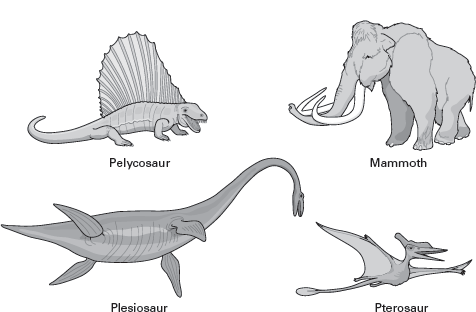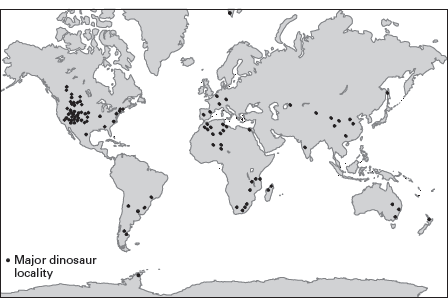IN 1842, British comparative anatomist Richard Owen (1804–1892) coined the word dinosaur. Owen constructed this word from the Greek words deinos, meaning “terrible” (though Owen considered it to mean “fearfully great”), and sauros, meaning “lizard” or “reptile.” To Owen, the “fearfully great lizards” were large, extinct reptiles known from only a handful of fossils discovered in western Europe since the 1820s. Today, dinosaur fossils are known from all continents and represent hundreds of distinct types of dinosaurs.
In this chapter, I briefly answer some basic questions about dinosaurs and introduce some topics discussed at greater length in this book.
Many people apply the term “dinosaur” to any large, extinct animal. To most people, any large extinct reptile qualifies as a dinosaur. Many even identify large, extinct mammals, such as wooly mammoths, as dinosaurs (
figure 1.1). Some authors and toy manufacturers perpetuate incorrect ideas about what a dinosaur is by presenting a variety of nondinosaurs as dinosaurs. Examples include the flying reptile
Pteranodon (a pterosaur) and the mammal-like reptile
Dimetrodon (a pelycosaur).
Dinosaurs are most easily thought of as a group of extinct reptiles that had an
upright posture. They first appeared about 225 to 230 million years ago and became extinct 66 million years ago. Birds, the descendants of dinosaurs, are still with us. Dinosaurs can be identified as reptiles because of their reptilian skeletal features and because dinosaurs, like many other reptiles, reproduced by laying hard-shelled eggs. The upright posture of dinosaurs, in which the legs extend directly underneath the body, distinguishes them from reptiles that hold their limbs out to the side of the body in a
sprawling posture (
figure 1.2). Large size is not a prerequisite for being a dinosaur, as some dinosaurs were no larger than a chicken. Skeletal features of one group of dinosaurs are remarkably like those of birds. These features indicate that dinosaurs were the ancestors of birds. Other skeletal features unique to dinosaurs will be discussed in
chapter 4. But, for now, we can define dinosaurs as reptiles with an upright posture and thereby identify them as a natural group with an evolutionary history distinct from that of other reptiles.

FIGURE 1.1
Although these kinds of animals are thought to be dinosaurs by many people, they are not. (Drawing by Network Graphics)
FIGURE 1.2
Dinosaurs are a group of extinct reptiles having an upright limb posture. In contrast, the limbs of other reptiles, such as lizards, are positioned at the sides of the body, in a sprawling posture. (Drawing by Network Graphics)
As mentioned, dinosaurs first appeared about 225 to 230 million years ago and became extinct 66 million years ago. So, dinosaurs lived on Earth for approximately 160 million years (
figure 1.3). Most paleontologists date the origin of humans at 2 or 3 million years ago. This means that dinosaurs persisted from 50 to 80 times as long as we have currently been on Earth. Movies and cartoons that portray humans and dinosaurs living side by side are very wrong.
Dinosaur fossils have long been collected in North America, Europe, Asia, South America, Africa, and Australia, and fossils were also discovered in Antarctica in 1989. So, we now have dinosaur fossils from all continents (
figure 1.4). At least 500 different kinds of dinosaurs have received scientific names. Their broad geographic distribution, their survival for about 160 million years, their variety in shape and size, and, in many instances, their extremely large size, identify dinosaurs as one of the most successful groups of land animals in the history of life.
FIGURE 1.3
Dinosaurs became extinct approximately 66 million years ago, more than 60 million years before humans appeared on Earth. (Drawing by Network Graphics)
FIGURE 1.4
Dinosaur fossils have been collected on all continents, including Antarctica. (Drawing by Network Graphics)
Dinosaurs fascinate most people, including young children. This fascination stems from their large size, strange shapes, and long-ago extinction. Some dinosaurs, such as Tyrannosaurus rex, one of the largest meat-eating land animals to have walked the earth, and certainly the most famous, terrify us. Other dinosaurs, such as Stegosaurus, puzzle us with their unusual body shape or armor. Clearly, one reason to study dinosaurs is because they are interesting.
Dinosaurs also are worth studying because they represent a unique episode in the history of life on this planet. They appeared some 225 to 230 million years ago, evolved into some of the largest and most successful land animals of all time, and then disappeared 66 million years ago. Dinosaurs clearly have much to teach us about evolution and extinction, especially of large animals.
So, we study dinosaurs for two reasons: first, because they interest us and, second, because they were an important part of the evolutionary history of life.
dinosaur
Richard Owen
sprawling posture
upright posture
1. What is a dinosaur?
2. Name some animals commonly thought to be dinosaurs that are not.
3. When and where did dinosaurs live?
4. What can the study of dinosaurs teach us?
To find a dinosaur, you need only visit a natural history museum or a state or national park. East of the Mississippi, your chances of finding a dinosaur are best served by a visit to the American Museum of Natural History (New York), the Carnegie Museum of Natural History (Pittsburgh, Pennsylvania), the Field Museum of Natural History (Chicago, Illinois), or the Smithsonian Institution’s National Museum of Natural History (Washington, D.C.). West of the Mississippi, try the Museum of the Rockies (Bozeman, Montana), the Wyoming Dinosaur Center (Thermopolis), the Denver Museum of Nature & Science, the New Mexico Museum of Natural History and Science (Albuquerque, New Mexico), and the Natural History Museum of Los Angeles County. In Canada, best bets are the Royal Ontario Museum (Toronto, Ontario), the Canadian Museum of Nature (Ottawa, Ontario), and the Royal Tyrrell Museum of Palaeontology (Drumheller, Alberta). You can also find dinosaurs in some state and national parks. These include Dinosaur State Park and Arboretum (Rocky Hill, Connecticut) and Clayton Lake State Park (Clayton, New Mexico), both of which have numerous dinosaur tracks (preserved dinosaur footprints). Probably the very best dinosaur fossil park in the United States is Dinosaur National Monument near Vernal, Utah. Here, Late Jurassic skeletons accumulated along a riverbank and are now displayed in a huge building erected over the bonebed. This is one of the world’s great dinosaur localities. There are also many dinosaur parks in cities across the country. For example, take a trip back in time at Dinosaur Park in Rapid City, South Dakota, with its vintage sculptures of dinosaurs created in the 1930s.




